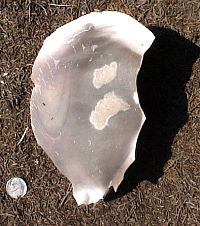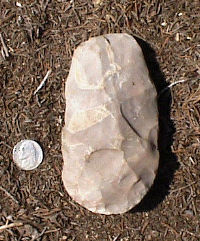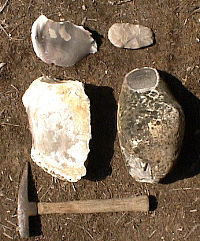1604 Flint
1604 flint was first recognized along Loop 1604 in northern Bexar County. This typically gray to brown chert is more recognizable by pink and light maroon tints. This variety, like Georgetown and Brushy Creek Black, occurs in the Edwards Limestone formation in the same narrow band that skirts the Balcones Escarpment. Similar cherts have been found in limestone quarries and other modern exposures from San Antonio to Temple.
1604 flint occurs most often in rounded nodules, with occasional flatter cobbles. Some of the nodules exposed by construction work along Loop 1604 were sizeable boulders in the 80-100 lb range. Naturally exposed cobbles are much smaller, probably because the big specimens were spotted used by ancient flintknappers thousands of years ago. Although this flint is generally of fair to good quality, the larger cobbles often have a central mass of lesser quality with an ‘inner rind’ of good material sandwiched between the center and the thick outer rind (cortex). The good material always has the darkest color, a mix of browns, pinks, and maroons. So, in this regard FM 1604 flint resembles Root Beer flint and some of the archeological cores from documented sites in northern Bexar County were “high graded” to remove the veneer of high quality material as described for the Root Beer variety.
![]()


